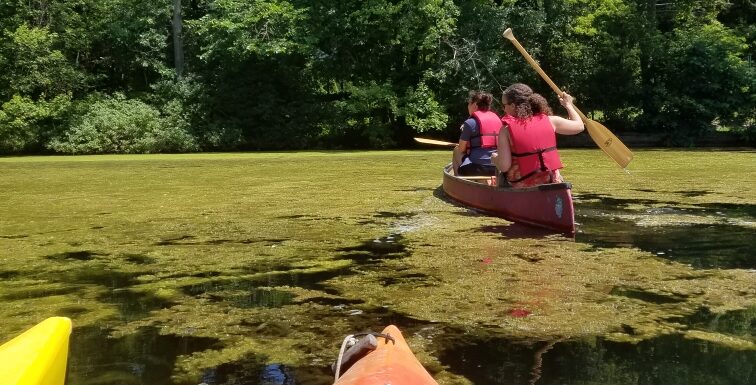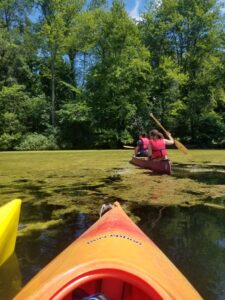
On a day like any other, you take your lunch and stroll out to your favorite spot by your local lake to sit and watch the ducks while you eat. When you arrive on this particular summer day, much to your horror, you see that an entire end of the lake is an unsightly green color, with a stench so foul that even the ducks are holding their noses from far away.
A bubbling, green, smelly lake may sound like something out of a nightmare, but the unfortunate reality is that many lakes and ponds have already reached this critical point.
Lake “greening,” or algae blooms, are a trademark sign of eutrophication. Approximately half of the lakes in the United States are already eutrophied, and 20% of these are hyper-eutrophied. In New York State alone, algae blooms are defined among the most important and common lake problems.
And eutrophication is only predicted to increase with temperature increases caused by climate change. Many of the cyanobacteria that indicate eutrophication have greater potential to bloom in higher water temperatures.
Eutrophication: Causes and Concerns
Eutrophication occurs from the combination of an abundance of:
- nutrients (nitrogen and phosphorus) from agriculture, runoff, wastewater treatment/septic systems
- light
- temperature
Unfortunately, eutrophication poses a variety of issues due to the harmful toxins released by the algae, including:
- fish kills
- beach closures
- the disruption of drinking water sources
- human health risks such as seizures, vomiting, and even death
Reducing nutrients has become the central means of mitigating eutrophication, and researchers are exploring the development of low-impact, green infrastructure as a sustainable solution.
Floating Treatment Wetlands: A Brief Overview
An innovative type of green infrastructure that can be used as biological mitigation for eutrophic lakes is the floating treatment wetland (FTW).
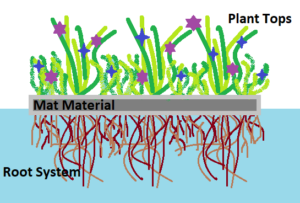
An FTW consists of above-water plants growing without soil, rooted in a floating mat. Its roots hang underwater in a complex system that draws excess nitrogen, phosphorus and other water contaminants (such as heavy metals) directly from the water.
Based on results across various initial studies, FTWs show great promise for water quality treatment. Through different models and controlled experiments, the benefits of FTWs have been widely recorded; they’ve even been studied with various plant species and climates, from tropical to temperate.
However, these studies describe a large range of variability for FTWs, which makes it complicated to standardize them and compare their effectiveness. Before they can be rolled out for large-scale future use, as much research as possible should go into understanding their full capacity and how their different variables affect the overall system.
This research would refine FTWs and make them an accessible and successful ecological tool to maintain lakes in the face of climate change and beyond.
Creating Your own Floating Treatment Wetland!
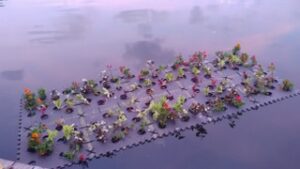
With the growing season upon us and many of us spending time at home, it’s worth the effort to do our part to ensure the health of any water bodies we may have direct access to. Familiarizing ourselves with the scale of eutrophication through interactive maps can be an immediate way to connect to the issue, whether local to you or elsewhere.
Doing your part could even take the form of creating your very own FTW! Not only is it a fresh and simple craft project to complete, it also fosters a sense of connection to your local water systems by knowing that you are contributing to their overall health.
The How To:
Choosing your mat
- Any floating material you have access to (plastic bottles work well!)
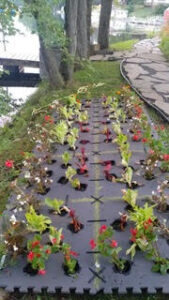
Basic FTW mat made by a resident of South Twin Lake (Elizaville, NY), using a commercial foam mat material and various plant species. Source: R. Smyth - They should be joined together well so that you have a usable surface area
- Combine your materials into any shape you choose (can be decorated if you would like!)
- Ensure your materials are not toxic and will not leach into or harm water
Choosing your plants
- Plants native to your area would be best!
- If you have aquatic plants available to you (cattails, etc) they are ideal
- Leafy green plants (lettuces, spinach, etc) may also be used
- Ornamental plants, for added flair, are a great addition as well!
- Mix and match!
Placing plants in your mat
- Your plants should have a complete and undisturbed root system
- Create as many holes in your mat as you have plants—make them large enough for the plants to slip through without damage, but not so big that they fall out (dirt or other growing media not necessary). Re-secure plants in mat holes if needed.
- Your plants’ roots should hang freely underneath the mat while the tops are exposed above and free to continue growing upwards
Good to go!
- Place your new FTW in your water body of choice (any pond or lake in your backyard or neighborhood will do)
- Be sure to check back frequently on your creation and watch it grow while also knowing you have done something to contribute to good water quality

